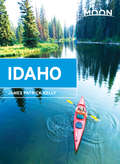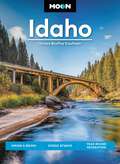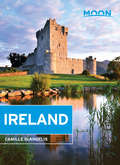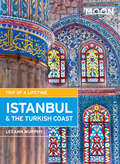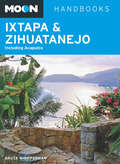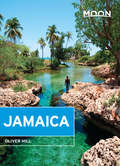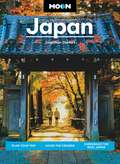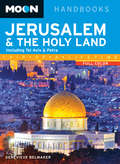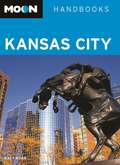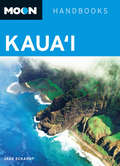- Table View
- List View
Moon Iceland: Waterfalls, Glaciers & Hot Springs (Moon Europe Travel Guide)
by Jenna Gottlieb Moon Travel GuidesLocal author Jenna Gottlieb reveals the best of Iceland, from breathtaking landscapes to unrivaled trekking. Experience it all with Moon Iceland. Inside you&’ll find: Strategic, flexible itineraries, from a three-day tour of Reykjavík to a weeklong best of Iceland, plus a nine-day road trip on the famed Ring RoadUnique experiences and can't-miss highlights: Drive past quaint towns and enormous fjords, hike through Iceland's majestic national parks, and bask in the shimmering glow of the northern lights. Stroll Reykjavík's busy streets, listen to up-and-coming bands at uniquely themed venues, and kick back with a handcrafted Icelandic beer at a local hangout The top outdoor activities: Search for seals, whales, and porpoises off the coast or spot arctic wildlife like puffins and reindeer onshore. Trek across a mighty glacier, hike the rim of a remote volcano, and relax in the milky blue waters of the Blue Lagoon. Explore crystalline ice caves and mineral-rich lava tubes or catch a rainbow glimmering over a thundering waterfall Full-color photos and detailed maps throughoutHonest advice from Reykjavík local Jenna Gottlieb on what to eat, where to stay, and when to go, including tips for traveling during the winter Handy tools including an Icelandic phrasebook and essential background information on the landscape, history, and culture Find your adventure with Moon Iceland. Heading to Scandinavia? Check out Moon Norway.About Moon Travel Guides: Moon was founded in 1973 to empower independent, active, and conscious travel. We prioritize local businesses, outdoor recreation, and traveling strategically and sustainably. Moon Travel Guides are written by local, expert authors with great stories to tell—and they can't wait to share their favorite places with you. For more inspiration, follow @moonguides on social media.
Moon Iceland: Waterfalls, Glaciers & Hot Springs (Travel Guide)
by Jenna GottliebBreathtaking landscapes, unrivaled trekking, and the creative spirit of Reykjavík: experience it all with Moon Iceland. Inside you'll find:Strategic, flexible itineraries, from a three-day tour of Reykjavík to a weeklong best of Iceland, plus a nine-day road trip on the famed Ring RoadUnique experiences and can't-miss highlights: Drive past quaint towns and enormous fjords, hike through Iceland's majestic national parks, and bask in the shimmering glow of the northern lights. Stroll Reykjavík's busy streets, listen to up-and-coming bands at uniquely themed venues, and kick back with a handcrafted Icelandic beer at a local hangout The top outdoor activities: Search for seals, whales, and porpoises off the Icelandic coast or spot arctic wildlife like puffins and reindeer onshore. Trek across a mighty glacier, hike the rim of a remote volcano, and relax in the milky blue waters of the Blue Lagoon. Explore crystalline ice caves and mineral-rich lava tubes or catch a rainbow appearing over a thundering waterfall Full-color photos and detailed maps throughoutHonest advice from local author Jenna Gottlieb on where to eat, where to stay, and when to go, including insight on traveling during the winter Handy tools including an Icelandic phrasebook and critical background information on the landscape, culture, history, and environment Find your adventure with Moon Iceland. Country-hopping in Scandinavia? Check out Moon Norway. Heading on to continental Europe? Try Moon Amsterdam, Brussels & Bruges.About Moon Travel Guides: Moon was founded in 1973 to empower independent, active, and conscious travel. We prioritize local businesses, outdoor recreation, and traveling strategically and sustainably. Moon Travel Guides are written by local, expert authors with great stories to tell—and they can't wait to share their favorite places with you. For more inspiration, follow @moonguides on social media.
Moon Iceland: With a Road Trip on the Ring Road (Travel Guide)
by Jenna GottliebBreathtaking landscapes, unrivaled trekking, and the creative spirit of Reykjavík: experience it all with Moon Iceland. Inside you'll find:Strategic, flexible itineraries, from a three-day tour of the best of Reykjavík to a nine-day road trip on the famed Ring Road, designed for outdoor adventurers, culture and history buffs, wildlife lovers, and moreUnique experiences and can't-miss highlights: Drive past quaint towns and enormous fjords, hike through Iceland's majestic national parks, and bask in the shimmering glow of the northern lights. Stroll Reykjavík's busy streets, listen to up-and-coming bands at uniquely themed venues, and kick back with a handcrafted Icelandic beer at a local hangout The top outdoor activities: Search for seals, whales, and porpoises off the Icelandic coast or spot arctic wildlife like puffins and reindeer onshore. Trek across a mighty glacier, hike the rim of a remote volcano, and relax in the milky blue waters of the Blue Lagoon. Explore crystalline ice caves and mineral-rich lava tubes or catch a rainbow appearing over a thundering waterfallFull-color photos and detailed maps throughoutHonest advice from local author Jenna Gottlieb on where to eat, where to stay, and when to go, including insight on traveling during the winterHandy tools including an Icelandic phrasebook and critical background information on the landscape, culture, history, and environmentFind your adventure with Moon Iceland.Country-hopping in Scandinavia? Check out Moon Norway. Heading on to continental Europe? Try Moon Barcelona & Madrid or Moon Rome, Florence & Venice.
Moon Idaho
by James P. KellySeasoned food, wine, and travel writer James P. Kelly offers his unique perspective on this remarkable travel destination, from free Wednesday night concerts at The Grove in Boise to the bizarre rock outcroppings of the Magic Valley. Kelly uses his local knowledge to craft original trip ideas, including Five Days of Fun in the Sawtooths, Birding in Idaho, and Exploring Backcountry Hot Springs. Complete with details on skiing Silver Mountain, exploring McCall's numerous hot springs, and noshing on contemporary Northwest fare in downtown Nampa, Moon Idaho gives travelers the tools they need to create a more personal and memorable experience.
Moon Idaho (Moon Handbooks)
by James Patrick KellySeasoned food, wine, and travel writer James Patrick Kelly offers his unique perspective on this remarkable travel destination, from free Wednesday night concerts at The Grove in Boise to the bizarre rock outcroppings of the Magic Valley. Kelly uses his local knowledge to craft original trip ideas, including Five Days of Fun in the Sawtooths, Birding in Idaho, and Exploring Backcountry Hot Springs. Complete with details on skiing Silver Mountain, exploring McCall's numerous hot springs, and noshing on contemporary Northwest fare in downtown Nampa, Moon Idaho gives travelers the tools they need to create a more personal and memorable experience.
Moon Idaho: Hiking & Biking, Scenic Byways, Year-Round Recreation (Travel Guide)
by Teresa Bruffey KaufmanEscape to the Gem State and discover a diverse landscape primed for endless adventure. Inside Moon Idaho you&’ll find:Strategic, flexible itineraries for 4-to-5-day road trips to visit Boise's wine country, Sun Valley and Sawtooth's mountains, or the lakes of the Panhandle Outdoor recreation: Raft on the Payette River, take a challenging hike, and paddle pristine turquoise lakes. Bike the Boise River Greenbelt, see multihued wildflowers in bloom, or take in celestial wonders in the first gold-tier dark sky reserve in the U.S. The top activities and unique experiences: Road trip the Thousand Springs Scenic Byway for waterfall photo-ops or experience Basque culture in vibrant Boise. Learn about the state&’s literary legacy or visit a historic ghost town. Savor fresh flavors at a farm-to-table restaurant and kick back with some of Idaho&’s delicious local microbrews Ways to respectfully engage with Indigenous cultures: Shop for handmade goods, visit a museum to learn about Indigenous history, or admire ancient petroglyphs Full-color photos and detailed maps throughoutExpert advice from Idaho local and lifelong adventurer Teresa Bruffey Kaufman Reliable background on the culture, weather, wildlife, and history, plus tips on driving conditions and traveling sustainably Find your adventure with Moon Idaho. Exploring nearby? Check out Moon Montana & Wyoming or Moon Oregon. Passing through? Try Moon Oregon Trail Road Trip.About Moon Travel Guides: Moon was founded in 1973 to empower independent, active, and conscious travel. We prioritize local businesses, outdoor recreation, and traveling strategically and sustainably. Moon Travel Guides are written by local, expert authors with great stories to tell—and they can't wait to share their favorite places with you. For more inspiration, follow @moonguides on social media.
Moon Ireland (Moon Travel Guides)
by Camille DeangelisMoon Travel Guides: Your World Your WayIn its people, legends, and landscapes, Ireland is a living, breathing fairy-tale that ignites the imagination in a way few other places can. Explore the best of The Emerald Isle with Moon Ireland.Moon Ireland features:Curated trip advice for culture and history buffs, outdoor adventurers, foodies, honeymooners, and more, whether you're in Ireland for a few days or a few weeksFull color photos and detailed maps throughoutStrategic itineraries for every budget, passion, and timeline, including: The Top 10 Irish Experiences, Sacred Sites and Pilgrimages, Can't-Miss-Castles, Sporting Ireland, Ghosts of Ancient Ireland, and Family FunFirsthand perspective from Ireland expert, and lifelong lover of its culture, Camille DeAngelisFocused coverage of Dublin and its surroundings (including Meath, Louth, Wicklow, and Kildare), the Southeast, Cork, Kerry, Clare and Limerick, Galway, the Northwest, and Northern IrelandHonest advice on when to go, where to stay, and how to get aroundUnique ideas and can't-miss activities: Visit the Old Library at Trinity College for a look at the world's most famous manuscript, take a breathtaking scenic drive along the Ring of Kerry, or breathe in the misty magnificence of the Cliffs of Moher. Soak up the bohemian spirit of Galway City, view the historic murals of Belfast, or spend a day cycling the Burren in County Clare. Visit a 6th-century monastery, the enchanting Aran Islands, or one of countless picturesque castles. Sample the best traditional cuisine, and head to a pub to order up a pint and experience Ireland's rollicking folk music sceneAccurate, up-to-date information including background on the country's history, landscape, government, and cultureHandy tools such as common local expressions, a guide to Irish cuisine and beverages, tips for traveling with children or as a senior, and suggestions for LGBTQ+ travelWith Moon Ireland's practical tips, myriad activities, and local insight on the best things to do and see, you can plan your trip your way.
Moon Ireland: Castles, Cliffs, and Lively Local Spots (Travel Guide)
by Camille DeAngelisFrom its stirring legends to its stunning landscapes, Ireland is a living, breathing fairy-tale. Ignite your imagination with Moon Ireland. Inside you'll find:Flexible itineraries from a two-week "Best of Ireland" adventure or a weekend in Dublin to 3-day tours of southern, northern, and coastal Ireland that can be combined into a longer tripStrategic ideas for history buffs, outdoor adventurers, foodies, honeymooners, families, and moreUnique ideas and can't-miss experiences: Visit the Old Library at Trinity College for a look at Ireland's most famous illuminated manuscript or drive past picturesque castles along the Ring of Kerry. Marvel at the misty magnificence of the Cliffs of Moher, wander through a 6th-century monastery, and ferry to the enchanting Aran Islands. Soak up the bohemian spirit of Galway City, take an introspective minute at the Bogside Peace Murals, or spend a day biking the Burren in County Clare. Head to a pub to order up a pint and enjoy a traditional meal while you experience Ireland's rollicking folk music sceneHonest insight from Ireland expert Camille DeAngelisFull color photos and detailed maps throughoutThorough background on the country's history, landscape, government, and cultureHelpful tools such as common local expressions and a guide to Irish cuisine and beverages, plus tips for traveling with children, seniors, travelers with disabilities, LGBTQ+ travelers, and travelers of colorFocused coverage of Dublin and its surroundings (including Meath, Louth, Wicklow, and Kildare), the Southeast, Cork, Kerry, Clare and Limerick, Galway, the Northwest, and Northern IrelandWith Moon Ireland's practical tips and local insight, you can experience the best of the Emerald Isle.Expanding your trip to the UK? Try Moon Edinburgh, Glasgow & the Isle of Skye or Moon London Walks.
Moon Israel & the West Bank: Including Petra (Moon Handbooks Ser.)
by Genevieve BelmakerThis full-color guide to Jerusalem includes vibrant photos and helpful planning maps.Calls to prayer echo out over valleys and rooftops. The wailing siren for Shabbat and the ringing of church bells are omnipresent. This is a city of religious pilgrimages and a land of ancient stories, where even the bodies of water whisper of history and miracles.This is the trip of a lifetime. It will leave you with a new sense of wonder-and some great stories to share. In this full-color book, expert traveler Genevieve Belmaker tells you everything you need to know to make this trip possible:How to get there, how long it will take, and where to stop along the way-including information on Jerusalem, Tel Aviv, Haifa, the West Bank, Eilat, and Petra, JordanHow to choose the best tours and means of transportation, including tips on border crossings.Background on religious and cultural sites, from the Western Wall and Dome of the Rock to the Church of the Nativity-and where to find them
Moon Israel & the West Bank: Planning Essentials, Sacred Sites, Unforgettable Experiences (Travel Guide)
by Genevieve BelmakerAncient stories meet modern cities in this deeply significant region where the past is always present. Take the trip of a lifetime with Moon Israel & the West Bank. Inside you'll find:Flexible, strategic itineraries including a week in Jerusalem, three days in Tel Aviv, and a month exploring the region plus excursions to the West Bank, the Dead Sea, and Petra The top sights and unique experiences: Visit the Church of the Holy Sepulchre or pay respects at the Western Wall, and stop at holy sites throughout Northern Israel and the West Bank. Feast on falafel, hummus, and shaksuka and haggle for antiques at a market in Jerusalem. Bike through Tel Aviv's charming Neve Tzedek neighborhood or relax at one of its beaches. Float in the Dead Sea, watch the sun set over the massive Negev craters, or stay overnight in a Bedouin tent encampment Local insight: Journalist and longtime Jerusalem resident Genevieve Belmaker shares the history and culture of her beloved former home Full-color, vibrant photos throughoutDetailed maps for exploring on your own, and useful tips on border crossings and checkpoints Thorough background information on the landscape, history, government, and culture Handy tools and planning essentials including Hebrew and Arabic phrasebooks, health and safety tips, customs and conduct, and information for LGBTQ, female, and senior travelers, families with children, travelers of color, and travelers with disabilities Focused coverage of Jerusalem, Tel Aviv, Haifa, the North Coast, the Galilee and the Golan Heights, the West Bank, Eilat and the Negev, and Petra, Jordan Experience the best of Israel and the West Bank with Moon's practical advice and insider tips. Exploring further? Check out Moon Egypt.About Moon Travel Guides: Moon was founded in 1973 to empower independent, active, and conscious travel. We prioritize local businesses, outdoor recreation, and traveling strategically and sustainably. Moon Travel Guides are written by local, expert authors with great stories to tell—and they can't wait to share their favorite places with you. For more inspiration, follow @moonguides on social media.
Moon Istanbul & the Turkish Coast: Including Cappadocia (Moon Handbooks)
by Leeann MurphyThis full-color guide to Istanbul and the Turkish coast includes vibrant photos and easy-to-use maps to help with trip planning.Over its 8,000-year history, Turkey's crown jewel has won the hearts of emperors and sultans. Today, Istanbul is a lively meeting place of East and West, religious and secular, traditional and modern. From the golden sands of the Mediterranean's beaches to the the world-class shopping and dining of Istanbul's charming neighborhoods; from the sublime hills of the the Turquoise Coast's Lycian Way to the architectural marvels of the Thracian Peninsula: this is the trip of a lifetime.In Moon Istanbul & the Turkish Coast, expert traveler Leeann Murphy tells you everything you need to know to make this trip possible.Experience the life of the city by wandering the Grand Bazaar and sampling authentic Turkish coffee and mezes.Appreciate Istanbul's past at the many historic and cultural sites, including the Ayasofya, the Blue Mosque, and Topkapi Palace.Plan a cruise along the Aegean Sea and the Turquoise Coast.Make inland excursions to Cappadocia and Ankara.Choose the best guides, tours, and means of transportation-including bus, boat, and even hot-air balloon.
Moon Ixtapa & Zihuatanejo
by Bruce WhippermanMoon Spotlight Ixtapa & Zihuatanejois a 60-page compact guide covering the best of Ixtapa and Zihuatanejo. Author Bruce Whipperman offers his firsthand advice on must-sees, and sightseeing highlight maps make planning your time easy. This lightweight guide is packed with recommendations for entertainment, shopping, recreation, accommodations, food, and transportation, and helpful maps will guide travelers through this popular vacation getaway. This Spotlight guidebook is excerpted fromMoon Acapulco, Ixtapa & Zihuatanejo.
Moon Jamaica (Moon Handbooks Ser.)
by Oliver HillMake your Escape with Moon Jamaica! Come to Jamaica for its tropical climate and calm Caribbean waters; stay to explore the heart of its vibrant culture and spirit with Moon Jamaica! What You'll Find in Moon Jamaica:Expert advice from local author Oliver Hill, who shares the best-kept secrets of his island homeFull-color, vibrant, helpful photos Detailed directions and maps for exploring on your ownIn-depth coverage of Negril and the West Coast, Montego Bay and the Northwest Coast, Ocho Rios and the North Central Coast, Port Antonio and the East Coast, Kingston and the Blue Mountains, The South CoastActivities and ideas for every traveler: Surf the turquoise waters, or relax on white sands. Get your adrenaline fix by cliff jumping or climbing the Blue Mountains. Hike through lush jungle to magnificent waterfalls, or move to the beat of Kingston's legendary music scene. Sample Jamaican rum and coffee, or dine beachfront at a luxurious resort. Eat freshly picked fruit for breakfast, watch hummingbirds flit about tropical flowers, or bathe in a crystal-clear spring on a hot day.Strategic itineraries in an easy-to-navigate format, such as The Best of Jamaica, Roots and Culture, and Hidden Beaches and Hillside HikesCurrent background information on the landscape, culture, history, and environmentEssential insight for travelers on health and safety, transportation, and accommodations, packaged in a book light enough to fit in your beach bagWith Moon Jamaica's practical tips, myriad activities, and an insider's view on the best things to do and see, you can plan your trip your way.Looking for more fun in the Caribbean sun? Check out Moon Aruba or Moon Dominican Republic.
Moon Jamaica (Travel Guide)
by Oliver HillDive in to warm Caribbean waters, soak up the sunshine, and discover the vibrant culture and spirit of Jamaica. Inside Moon Jamaica you'll find:Flexible, strategic itineraries with ideas for backpackers, beach-lovers, adventure travelers, honeymooners, wellness-seekers, and moreTop activities and unique experiences: Watch hummingbirds flit about tropical flowers, take a dip in a crystal-clear spring on a hot day, or relax on soft white sands. See beloved local bands perform at a Negril nightclub and move to the beat of Kingston's legendary music scene. Savor sweet Jamaican rum and coffee, chow down on authentic jerk chicken, or have a romantic beachfront dinnerOutdoor adventures: Cliff-jumping into azure waters, surf the waves, climb the Blue Mountains, or hike through lush jungleFind the best beaches for surfing, sunsets, seclusion, and moreInsight from Kingston local Oliver Hill on how to experience Jamaica like an insider, support local and sustainable businesses, avoid over-tourism, and respectfully engage with the cultureFull-color photos and detailed maps throughoutBackground information on Jamaica's landscape, history, and cultural customsHandy tools including a glossary of Jamaican Patois terms, packing suggestions, and tips for women traveling alone, families with kids, seniors, and LGBTQ travelersExperience the best of Jamaica with Moon.Exploring more of the Caribbean? Check out Moon Bahamas, Moon Aruba, or Moon Dominican Republic.
Moon Japan: Plan Your Trip, Avoid the Crowds, Experience the Real Japan (Moon Asia & Pacific Travel Guide)
by Moon Travel Guides Jonathan DeHartJapan expert Jonathan DeHart shows travelers how to experience the natural wonder and rich culture of a country that blends modernity and tradition unlike any other. From the world's busiest intersection to the most serene hot springs, inside Moon Japan you'll find:Flexible itineraries including a two week 'Best of Japan' and 11 days in Hokkaido The top sights and unique experiences: Wander the shrines and temples of Ueno-koen park and stop in Tokyo National Museum for world-renowned Japanese art. Learn about samurai heritage in Sanmachi Suji or zazen meditation at the Buddhist temples of Kyoto, and get an unforgettable lesson in 20th century history at Hiroshima Peace Memorial Park Outdoor adventures: Hike the trails of Mt. Fuji or the river-filled valley of Kamikochi and relax in a communal onsen hot spring. Ski or snowboard at a world-class resort, surf in the Pacific off the coast of Shikoku, or dive along the coral reefs of Okinawa The best local flavors: Feast on ramen or an elaborate spread of sushi, sample fresh seafood at the world's largest fish market in Tokyo, and drink your way through the famed beer scene in Sapporo Honest insight from American expat and longtime Tokyo local Jonathan DeHart Full-color, vibrant photos throughoutDetailed maps and useful tips for navigating public transportation Focused coverage of Tokyo, Mt. Fuji, Kanazawa, Kyoto, Kansai, Hiroshima and Miyajima, Okinawa, Tohoku and Hokkaido, Shikoku and Kyushu, and more Thorough background information on the landscape, wildlife, history, government, and culture With Moon's practical advice and insider tips, you can experience the best of Japan. Just exploring the cities? Check out Moon Tokyo, Kyoto & Hiroshima or Moon Tokyo Walks.About Moon Travel Guides: Moon was founded in 1973 to empower independent, active, and conscious travel. We prioritize local businesses, outdoor recreation, and traveling strategically and sustainably. Moon Travel Guides are written by local, expert authors with great stories to tell—and they can&’t wait to share their favorite places with you. For more inspiration, follow @moonguides on social media.
Moon Japan: Plan Your Trip, Avoid the Crowds, and Experience the Real Japan (Travel Guide)
by Jonathan DeHartFrom the world's busiest intersection to the most serene hot springs, modernity and tradition mingle in Japan. Experience the natural wonder and rich culture of a country unlike any other with Moon Japan. Inside you'll find:Flexible itineraries including a two week 'Best of Japan' and a week in and around TokyoStrategic advice for spiritual seekers, anime fans, foodies, fashionistas, hikers, and moreThe top sights and unique experiences: Wander the shrines and temples of Ueno-koen park and stop in Tokyo National Museum for world-renowned Japanese art. Learn about samurai heritage in Sanmachi Suji or zazen meditation at the Buddhist temples of Kyoto, and get an unforgettable lesson in 20th century history at Hiroshima Peace Memorial Park Outdoor adventures: Hike the trails of Mt. Fuji or the river-filled valley of Kamikochi and relax in a communal onsen hot spring. Ski or snowboard at a world-class resort, surf in the Pacific off the coast of Shikoku, or dive along the coral reefs of OkinawaThe best local flavors: Feast on ramen or an elaborate spread of sushi, sample fresh seafood at the world's largest fish market in Tokyo, and drink your way through the famed beer scene in SapporoHonest insight from American expat and longtime Tokyo local Jonathan DeHartFull-color, vibrant photos throughoutDetailed maps and useful tips for navigating public transportation Focused coverage of Tokyo, Mt. Fuji, Kanazawa, Kyoto, Kansai, Hiroshima and Miyajima, Okinawa, Tohoku and Hokkaido, Shikoku and Kyushu, and moreThorough background information on the landscape, wildlife, history, government, and cultureHandy tools including health and safety tips, customs and conduct, and information for LGBTQ, female, and senior travelers, as well as families and travelers with disabilitiesWith Moon's practical advice and insider tips, you can experience the best of Japan.Exploring more of Asia? Check out Moon Vietnam.
Moon Japan: Plan Your Trip, Avoid the Crowds, and Experience the Real Japan (Travel Guide)
by Jonathan DeHartFrom the world's busiest intersection to the most serene hot springs, modernity and tradition mingle in Japan. Experience the natural wonder and rich culture of a country unlike any other with Moon Japan. Inside you'll find:Flexible itineraries including a two week 'Best of Japan' and a week in and around Tokyo The top sights and unique experiences: Wander the shrines and temples of Ueno-koen park and stop in Tokyo National Museum for world-renowned Japanese art. Learn about samurai heritage in Sanmachi Suji or zazen meditation at the Buddhist temples of Kyoto, and get an unforgettable lesson in 20th century history at Hiroshima Peace Memorial Park Outdoor adventures: Hike the trails of Mt. Fuji or the river-filled valley of Kamikochi and relax in a communal onsen hot spring. Ski or snowboard at a world-class resort, surf in the Pacific off the coast of Shikoku, or dive along the coral reefs of Okinawa The best local flavors: Feast on ramen or an elaborate spread of sushi, sample fresh seafood at the world's largest fish market in Tokyo, and drink your way through the famed beer scene in Sapporo Honest insight from American expat and longtime Tokyo local Jonathan DeHart Full-color, vibrant photos throughoutDetailed maps and useful tips for navigating public transportation Focused coverage of Tokyo, Mt. Fuji, Kanazawa, Kyoto, Kansai, Hiroshima and Miyajima, Okinawa, Tohoku and Hokkaido, Shikoku and Kyushu, and more Helpful resources on Covid-19 and traveling to Japan Thorough background information on the landscape, wildlife, history, government, and culture Handy tools including health and safety tips, customs and conduct, and information for LGBTQ, female, and senior travelers, as well as families and travelers with disabilities With Moon's practical advice and insider tips, you can experience the best of Japan. Just exploring the major cities? Check out Moon Tokyo, Kyoto & Hiroshima.About Moon Travel Guides: Moon was founded in 1973 to empower independent, active, and conscious travel. We prioritize local businesses, outdoor recreation, and traveling strategically and sustainably. Moon Travel Guides are written by local, expert authors with great stories to tell—and they can't wait to share their favorite places with you. For more inspiration, follow @moonguides on social media.
Moon Jerusalem & the Holy Land
by Genevieve BelmakerThis full-color guide to Jerusalem includes vibrant photos and helpful planning maps.Calls to prayer echo out over valleys and rooftops. The wailing siren for Shabbat and the ringing of church bells are omnipresent. This is a city of religious pilgrimages and a land of ancient stories, where even the bodies of water whisper of history and miracles.This is the trip of a lifetime. It will leave you with a new sense of wonder-and some great stories to share. In this full-color book, expert traveler Genevieve Belmaker tells you everything you need to know to make this trip possible:How to get there, how long it will take, and where to stop along the way-including information on Jerusalem, Tel Aviv, Haifa, the West Bank, Eilat, and Petra, Jordan.How to choose the best tours and means of transportation, including tips on border crossings.Background on religious and cultural sites, from the Western Wall and Dome of the Rock to the Church of the Nativity-and where to find them.This ebook and its features are best experienced on iOS or Android devices and the Kindle Fire.
Moon Jerusalem (Travel Guide)
by Genevieve BelmakerMoon Travel Guides: Your World, Your WayIn the timeless city of Jerusalem, the past feels ever-present. Thousands of years of epic history are visible on every stone of this thriving capital. Immerse yourself in the mesmerizing mix of ancient and modern with Moon Jerusalem.What you'll find in Moon Jerusalem:Strategic itineraries from three days to a week in Jerusalem, featuring pilgrimage destinations and historical sites for three of the worlds major religions Full-color guidebook with vibrant, helpful photos, all in an easy-to-navigate formatDetailed directions and maps for exploring on your own, as well as tips for choosing the best tours (the Saturday tours are free!)Activities and ideas for every traveler: Wind through the tightly packed shops of the Old City, and try your hand at the time-honored custom of haggling. Explore archaeological and cultural sites like the Western Wall, the Dome of the Rock, the Al-Aqsa Mosque, and the Church of the Nativity. Walk where many believe Jesus Christ was resurrected in the Church of the Holy Sepulchre, and look out over old and new Jerusalem from a rooftop café with a plate of shakshuka. Gain insight into the history of the Holocaust at Yad Vashem, and meditate on the sweeping views of the Jerusalem forest. Taste your way through Jerusalem's famous market the Shuk, or stay after the sun goes down to watch it turn into a lively street partyCurated advice from journalist and local expert Genevieve Belmaker, who shares what shes learned from her years living in this ancient and beautiful cityBackground info on the landscape, culture, and political historyEssential insight for travelers on safety, LGBTQ travel, local customs and etiquette, visas, and transportation in and around the cityAdditional resources like Hebrew and Arabic phrasebooks and suggested reading, packaged in a book slim enough to fit in your coat pocketWith Moon Jerusalem's practical tips, myriad activities, and an insiders view on the best things to do and see, you can plan your trip your way.Expanding your trip? Try Moon Israel & The West Bank. Hoping to country-hop? Check out Moon Istanbul & the Turkish Coast.
Moon Joshua Tree & Palm Springs (Travel Guide)
by Jenna BloughFrom the chic pools of Palm Springs to the rugged alien beauty of Joshua Tree National Park, soak up the California sunshine with Moon Joshua Tree & Palm Springs. Inside you'll find: Flexible itineraries, like relaxing weekends in Palm Springs and the Coachella Valley and the week-long best of Joshua Tree National Park, including day trips to the Salton Sea and IdyllwildStrategic advice for outdoor adventurers, spa-seekers, poolside loungers, and moreThe best hikes in Joshua Tree and the Palm Springs area marked with mileage, duration, difficulty level, and elevation gain, plus trailheads and detailed directionsTop activities and unique experiences: Discover hidden waterfalls, fan palm oases, and stunning canyons on a hike through Joshua Tree, or trek part of the Pacific Crest Trail on a day trip to the Sand to Snow National Monument. Try a rejuvenating sound bath, soak in serene hot springs, and discover hidden fan palm oases. Admire mid-century architecture and sip retro-chic cocktails in Rat-Pack-era hangouts, and sample the best of the party scene, from poolside resorts and live music venues to wild west saloonsInsider advice from SoCal local Jenna Blough on when to go, where to stay, and how to get around, including how to get to Joshua Tree and Palm Springs from Los AngelesFull-color photos and detailed maps throughout Background information on the landscape, history, and culture and tips for families, seniors, LGBTQ travelers, and visitors with disabilitiesExperience the best of the desert with Moon Joshua Tree & Palm Springs' practical tips and local insight.Exploring the national parks? Check out Moon Death Valley National Park or Moon Yosemite, Sequoia & Kings Canyon.
Moon Joshua Tree & Palm Springs: Hiking, Scenic Drives, Desert Getaways (Moon National Parks Travel Guide)
by Jenna Blough Moon Travel GuidesFrom the chic pools of Palm Springs to the rugged beauty of Joshua Tree National Park, soak up the California sunshine with Moon Joshua Tree & Palm Springs. Inside you'll find: Flexible itineraries, like a three-day camping trip in Joshua Tree National Park and a relaxing five-day stay in Palm Springs and the Coachella Valley, including day trips to Whitewater Preserve and Idyllwild Strategic advice for outdoor adventurers, spa-seekers, poolside loungers, and more The best hikes in Joshua Tree and the Palm Springs area marked with mileage, duration, difficulty level, and elevation gain, plus trailheads and detailed directions Top activities and unique experiences: Discover hidden waterfalls, fan palm oases, and stunning canyons on a hike through Joshua Tree, or trek part of the Pacific Crest Trail on a day trip to the Sand to Snow National Monument. Try a rejuvenating sound bath or soak in serene hot springs. Admire midcentury architecture and sip retro-chic cocktails in Rat-Pack-era hangouts and sample the best of the party scene, from poolside resorts to wild west saloons Insider advice from SoCal local Jenna Blough on when to go, where to stay, and how to get around, including how to get to Joshua Tree and Palm Springs from Los Angeles Full-color photos and detailed maps throughout Background information on the landscape, history, and culture Experience the best of the desert with Moon Joshua Tree & Palm Springs. Exploring California&’s national parks? Check out Moon Death Valley National Park or Moon Yosemite, Sequoia & Kings Canyon.About Moon Travel Guides: Moon was founded in 1973 to empower independent, active, and conscious travel. We prioritize local businesses, outdoor recreation, and traveling strategically and sustainably. Moon Travel Guides are written by local, expert authors with great stories to tell—and they can't wait to share their favorite places with you. For more inspiration, follow @moonguides on social media.
Moon Joshua Tree & Palm Springs: Hiking, Scenic Drives, Desert Getaways (Travel Guide)
by Jenna BloughFrom the chic pools of Palm Springs to the rugged beauty of Joshua Tree National Park, soak up the California sunshine with Moon Joshua Tree & Palm Springs. Inside you'll find: Flexible itineraries, like relaxing weekends in Palm Springs and the Coachella Valley and the week-long best of Joshua Tree National Park, including day trips to the Salton Sea and Idyllwild Strategic advice for outdoor adventurers, spa-seekers, poolside loungers, and more The best hikes in Joshua Tree and the Palm Springs area marked with mileage, duration, difficulty level, and elevation gain, plus trailheads and detailed directions Top activities and unique experiences: Discover hidden waterfalls, fan palm oases, and stunning canyons on a hike through Joshua Tree, or trek part of the Pacific Crest Trail on a day trip to the Sand to Snow National Monument. Try a rejuvenating sound bath or soak in serene hot springs. Admire mid-century architecture and sip retro-chic cocktails in Rat-Pack-era hangouts and sample the best of the party scene, from poolside resorts to wild west saloons Insider advice from SoCal local Jenna Blough on when to go, where to stay, and how to get around, including how to get to Joshua Tree and Palm Springs from Los Angeles Helpful resources on Covid-19 and traveling to Joshua Tree and Palm Springs Full-color photos and detailed maps throughout Background information on the landscape, history, and culture, plus tips for families, seniors, LGBTQ travelers, and visitors with disabilities Experience the best of the desert with Moon Joshua Tree & Palm Springs. Exploring California&’s national parks? Check out Moon Death Valley National Park or Moon Sequoia & Kings Canyon. About Moon Travel Guides: Moon was founded in 1973 to empower independent, active, and conscious travel. We prioritize local businesses, outdoor recreation, and traveling strategically and sustainably. Moon Travel Guides are written by local, expert authors with great stories to tell—and they can't wait to share their favorite places with you. For more inspiration, follow @moonguides on social media.
Moon Kansas City
by Katy RyanMissouri native Katy Ryan covers the best of the Kansas City area, including River Market, Crossroads, Westport, and Brookside. Ryan provides travel strategies including "The Best of Kansas City in 4 Days" and explores the city's notable restaurants, arts, and entertainment. Complete with expert tips that appeal to a variety of interests ranging from shopping to outdoor recreation, Moon Kansas City gives travelers the tools they need to create a more personal and memorable experience.
Moon Kaua'i
by Jade EckardtTravel writer and Hawai'i resident Jade Eckardt knows the best ways to experience Kaua'i, from catching waves in Hanalei Bay to watching the sun set over Ni'ihau from a beach on the West Side. InMoon Kaua'i,Eckardt offers a range of interesting activities for every traveler, with suggested itineraries like Best Waterfalls, Go Green on the Garden Isle, and Love of the Land#151;a guide to the island's best hikes. Packed with information on dining, transportation, and accommodations,Moon Kaua'igives travelers the tools they need to create a more personal and memorable experience.
Moon Kaua'i (Moon Handbooks)
by Kevin WhittonMake Your Escape!A verdant retreat full of old Hawaii charm, Kaua'i is aloha at its best. See the soul of Hawaii with Moon Kaua'i, the travel guide preferred by locals. What You'll Find in Moon Kaua'i:Expert, local author Kevin Whitton provides an adventurer's perspective on the island he calls homeFull-color guides with vibrant, helpful photos, in an easy-to-navigate formatDetailed directions and over 20 maps for exploring on your ownKaua'i travel itineraries for every trip and budget with options for rainy days, including: The Best of Kaua'i, Honeymoon Hotspots, Best Beaches, Underwater Paradise, Best Outdoor Adventures, Waterfall Wonders, and Best Cultural and Historic SitesIn-depth coverage for Lihu'e and the East Side, Princeville and the North Shore, Po'ipu and the South Shore, and Waimea and the West SideHonest advice on finding the best accommodations, accessible transportation, and experiencing the real Kaua'iActivities and ideas for every traveler: snorkel the coral reefs, ride the waves, or relax in the sun. Hike the famed Na Pali Coast or the breathtaking Waimea Canyon. Pick up paddle-boarding or learn to scuba dive. Discover the most beautiful waterfall or catch the best sunset for a romantic getawayNuanced background, including information on the landscape, plants and animals, history, and cultureHandy tools such as detailed lodging information and suggestions on LGBT+ travel and eco-tourism, all in a book light enough for your beach bagWith Moon Kaua'i's practical tips, myriad activities, and local insight on the best things to do and see, you can plan your trip your way. Interested in island hopping? Check out Moon Big Island of Hawai'i, Moon Honolulu & O'ahu, and Moon Maui. Visiting all the islands? Check out Moon Hawaiian Islands.




